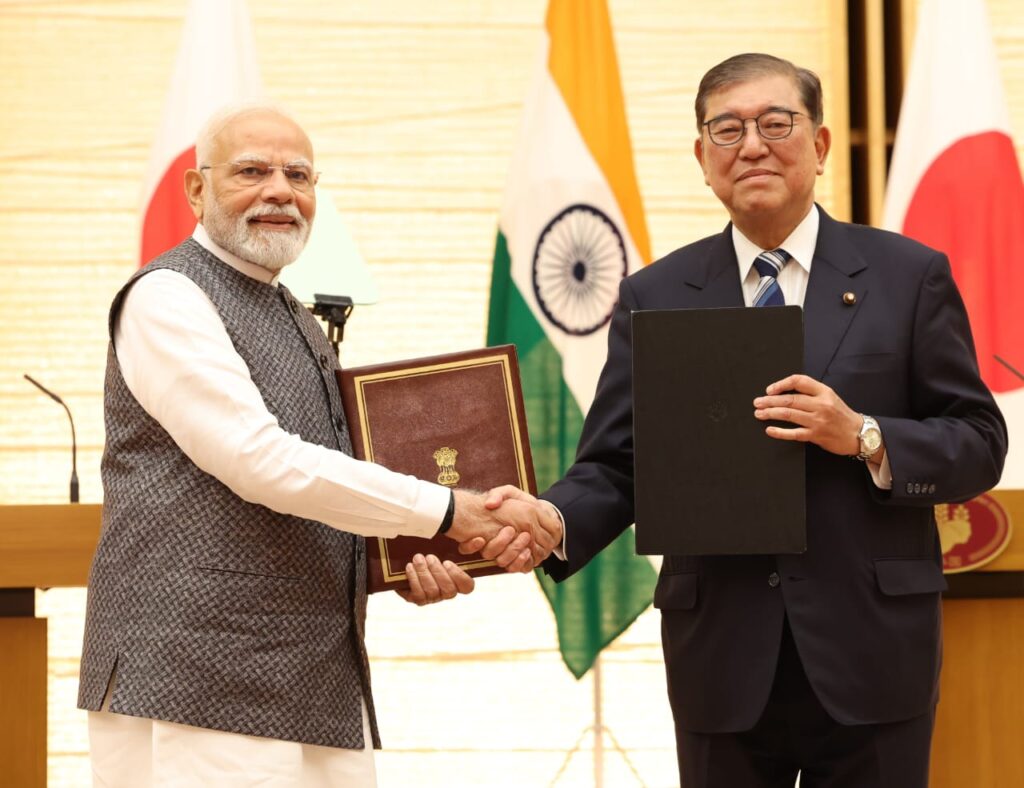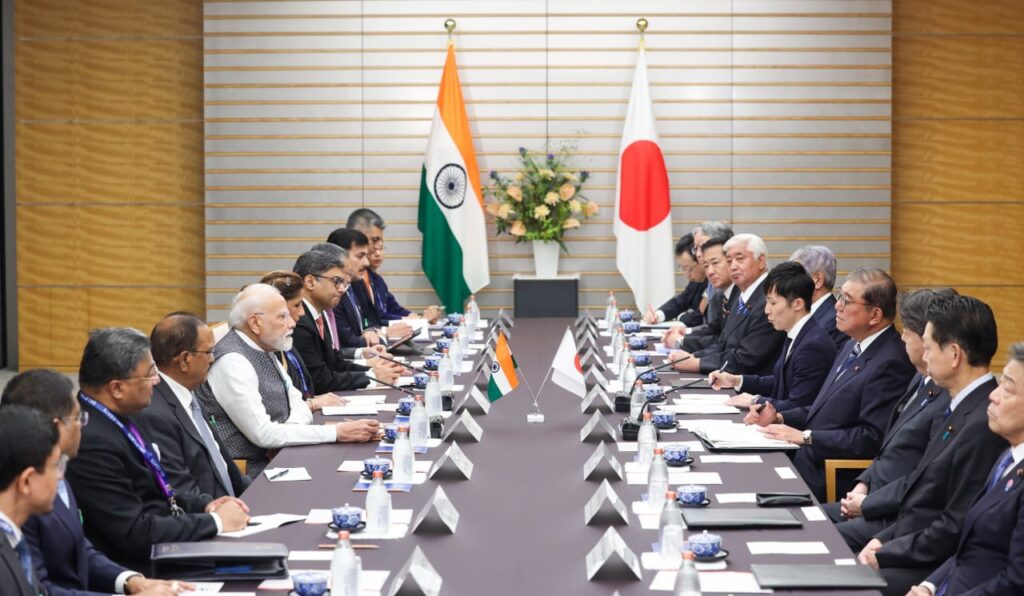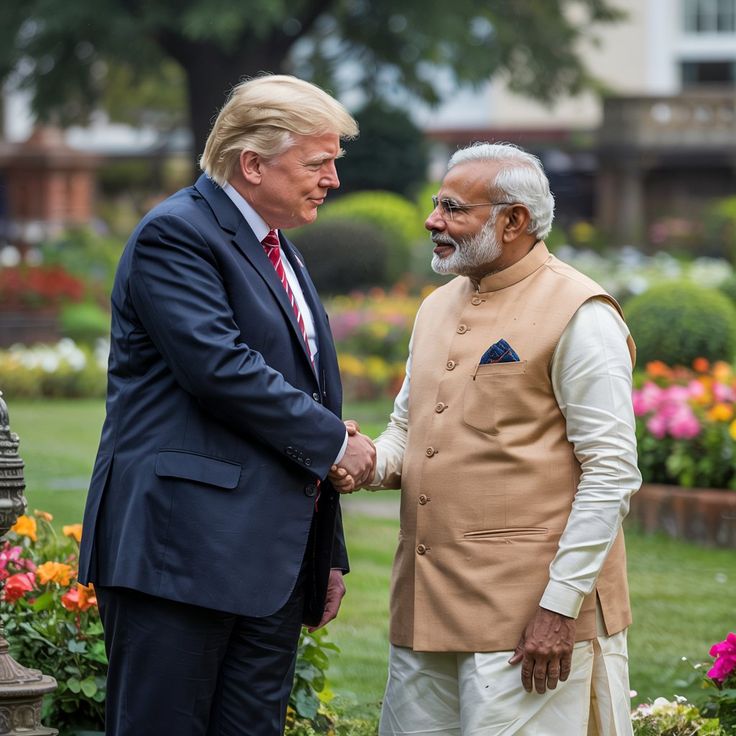In a dazzling display of friendship, Tokyo’s Skytree tower illuminated in the Indian Tricolor as Prime Minister Modi arrived in Japan. The visit saw Japan pledge $68 billion for India, PM Kishida praising Varanasi’s timeless heritage, and a symbolic Daruma Doll gift highlighting resilience, trust, and shared cultural bonds.
A Grand Welcome in Tokyo
On a cool Tokyo evening, the skyline witnessed an unforgettable sight—the Tokyo Skytree tower glowing in the Indian Tricolor. The tallest structure in Japan, and one of the most recognized landmarks worldwide, symbolically celebrated the arrival of Indian Prime Minister Narendra Modi. The meticulously planned lighting, which featured saffron, white, and green hues, served as both a cultural salute and a diplomatic gesture from Japan, demonstrating the two countries’ long-standing relationship.
Large crowds of Indians living in Japan gathered at the Skytree precinct to wave the Indian flag and take photos. The event was characterized by many as “historic” and “emotional,” highlighting the strong emotional bond that the Indian diaspora has with their birthplace.
This was not just a ceremonial spectacle; it was a powerful statement of solidarity, mutual respect, and the growing strategic importance of India-Japan relations.
The Press Meet: Cementing Strategic Partnerships
Alongside the ceremonial welcome, Prime Minister Modi and Japanese leaders engaged in a high-profile press meet attended by diplomats, business leaders, and media representatives. The meeting was more than just symbolic; it laid out the framework for bilateral collaboration in the areas of global governance, trade, technology, and defense.
Modi emphasized India’s vision of a free, open, and inclusive Indo-Pacific, aligning closely with Japan’s security framework. Both nations have long expressed concerns over regional security challenges, making their partnership pivotal for ensuring stability in Asia.
Japanese Prime Minister Fumio Kishida highlighted that India is not just a regional partner but also a global ally in shaping economic and strategic frameworks for the 21st century.
In one of the most significant announcements, Japan pledged $68 billion in investment for India over the next five years. This investment will focus on infrastructure, green technology, semiconductors, smart cities, and high-speed rail projects, further accelerating India’s modernization.
Kishida’s comments blended cultural sensitivity with business wisdom. Recalling his earlier trip to Varanasi, he said: “After visiting Varanasi, I was in awe of Indian history. The city’s culture and spiritual depth left a profound impression on me.” His words highlighted how Japan values not just India’s economic rise, but also its civilizational heritage.
A Special Gift: The Daruma Doll
In a symbolic moment during the press meet, Prime Minister Narendra Modi was presented with a Daruma Doll, a deeply meaningful cultural icon in Japan. Traditionally, the doll represents resilience, good luck, and the spirit of never giving up.
The Daruma Doll is usually given with blank eyes—one eye is filled in when a person sets a goal, and the second eye is completed upon achieving it. By presenting this to Modi, Japan sent a powerful message: confidence in India’s journey, and faith in the India-Japan partnership to achieve their shared vision for the future.
Modi, visibly moved by the gesture, described the Daruma Doll as a symbol of “trust, perseverance, and determination”—qualities he said both India and Japan embody.
Historical Significance of India-Japan Relations
India and Japan share a history that transcends politics—it is rooted in cultural affinity, spiritual connections, and shared values. From Buddhism’s spread centuries ago to today’s high-tech collaborations, the ties have evolved while maintaining warmth and mutual respect.
- Post-War Relations: Following India’s independence in 1947, Japan was one of the first nations to back the country.
- Economic Cooperation: Japan was the first country to offer yen loans to India for infrastructural projects in 1958.
- Cultural Diplomacy: Exchanges in art, cinema, literature, and education have kept the bond vibrant.
- Strategic Ties: The transformation in the 21st century has seen defense and technology emerge as major pillars.
The illumination of Tokyo’s Skytree in Indian colors was not just a tribute to Modi’s visit but a symbol of how Japan views India—as a partner in shaping the global order.
Symbolism of the Skytree Illumination
The Skytree’s tricolor display carried deep symbolic meaning. Saffron signified strength and courage, white stood for peace and truth, while green represented growth and harmony.
Lighting up the 634-meter tall tower with these colors was a message of India’s rising global stature. It also reinforced the people-to-people connection, as many Indian expatriates in Tokyo saw it as a bridge between their two homes.
For Japan, the gesture displayed not only respect for Modi as a leader but also recognition of India as a key Asian power in economic, strategic, and cultural terms.
Press Meet Highlights: Key Announcements
The bilateral press engagement produced several notable takeaways:
- Defense and Security Cooperation
- Expansion of joint naval exercises in the Indian Ocean and East China Sea.
- Enhanced intelligence-sharing mechanisms to address cyber threats.
- Collaboration on emerging defense technologies, including unmanned aerial vehicles.
2. Economic and Trade Relations
- Japan pledges $68 billion investment in India for high-speed rail, semiconductors, and green energy.
- New initiatives in digital technology, AI, and blockchain.
- Enhanced bilateral trade corridors and industrial hubs.
3. Cultural Diplomacy
- delivering the Daruma Doll, a representation of friendship and tenacity, to PM Modi.
- Launch of a “Japan-India Youth Exchange Program” to allow more student mobility.
- Plans for cultural festivals celebrating both nations’ heritage.
4. Global Cooperation
- Joint initiatives on climate change through clean energy projects.
- Coordinated positions in multilateral platforms like the G20 and QUAD.
- Pledge to advocate for reform of international institutions like the UN Security Council.
The Growing Role of the Indian Diaspora in Japan
One of Modi’s major highlights of the trip was his interaction with the Indian community in Japan. The diaspora, now numbering over 40,000, has become a vital bridge connecting the two countries.
At the press meet, several community leaders expressed gratitude to Japan for welcoming Indian talent in IT, education, and healthcare. Modi, in turn, acknowledged the role of overseas Indians in enhancing the country’s global image.
The illuminated Skytree became a backdrop for many diaspora celebrations, with cultural performances, Indian food stalls, and spontaneous gatherings in Tokyo marking the occasion.
Modi-Kishida Dynamics: A Personal Bond
During the tour, Prime Minister Modi and his Japanese colleague Fumio Kishida demonstrated a close personal relationship. Over the years, the two leaders have met several times, frequently emphasizing their warmth and trust in one another.
Observers noted how Kishida’s decision to illuminate the Skytree was more than a protocol—it was an expression of camaraderie. Modi, in his remarks, praised Kishida for his leadership in steering Japan through challenging global times and reaffirmed India’s unwavering friendship.
Kishida’s Varanasi meditation and the Daruma Doll presentation, which fused cultural awe with political trust, further emphasized this relationship.
Global Implications of India-Japan Ties
The strengthening of India-Japan relations is not happening in isolation. Analysts see this partnership as central to shaping the future of the Indo-Pacific and counterbalancing shifting global dynamics.
- Geopolitical Importance: With China’s growing influence, India and Japan’s strategic partnership provides balance in Asia.
- Economic Impact: With Japan’s $68 billion investment pledge, India is set to accelerate industrialization and infrastructure growth.
- Technological Edge: Collaboration in AI, robotics, semiconductors, and green tech has the potential to shape industries worldwide.
Thus, the press meet was not just bilateral diplomacy—it was a signal to the global community that India and Japan stand together as partners of progress.
Voices from Tokyo: Public Reactions
Japanese citizens, curious about the tricolor illumination, shared their admiration for India’s culture and leadership. Many locals visited the Skytree area to witness the vibrant display, with some describing it as a “fusion of traditions” between two great civilizations.
Indian students and professionals in Tokyo took to social media, flooding platforms with images of the glowing tower. Phrases like “Two democracies shining together” and “Proud to be Indian tonight in Japan” were popular among the diaspora.
A Vision for the Future
As the visit concluded, the symbolism of the Skytree lights remained etched in memory, but the real outcome lay in the ambitious vision outlined at the press meet. Both nations are looking beyond immediate gains, towards a partnership that could redefine the balance of power, innovation, and culture in Asia.
PM Modi summarized it best during his speech: “The illumination of the Skytree in Indian colors is not just a welcome—it is a beacon of the bright future India and Japan will build together.”
Prime Minister Narendra Modi’s Tokyo visit combined powerful symbolism with substantive outcomes. The Skytree glowing in the Indian Tricolor provided a stunning visual of friendship, while the press meet laid down a concrete roadmap for deeper cooperation.
For India and Japan, this visit reaffirmed that their partnership is more than diplomacy—it is a strategic, cultural, and emotional alliance destined to shape the Asian century.
“After visiting Varanasi, I was in awe of Indian history,” Kishida reminded the world. Both countries also reaffirmed their commitment to progress, resilience, and a common vision of peace and prosperity with Japan’s $68 billion investment pledge and the symbolic gift of the Daruma Doll.
Related News: Read More





Pingback: From Tokyo to Beijing: PM Modi Begins SCO After 7 Years